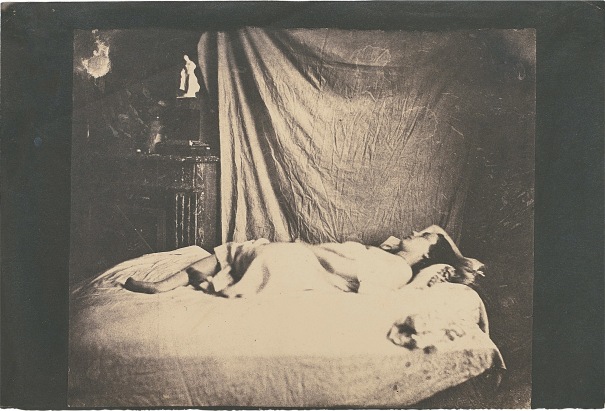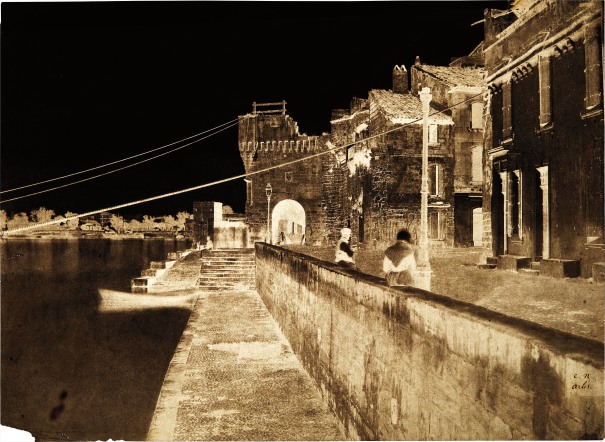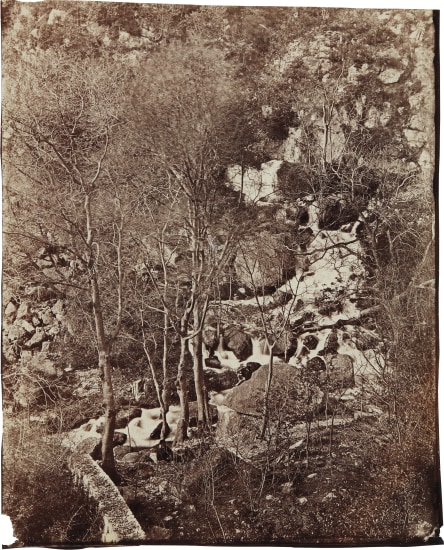Charles Nègre Self-Portrait in Orientalist Costume circa 1860 Albumen print, mounted. 7 3/4 x 5 3/8 in. (19.7 x 13.7 cm)
Provenance Nègre Family Collection Joseph Nègre, great grandson of the artist Charles Isaacs Photographs, Inc., New York, 1993 Catalogue Essay An additional print of this image is in the collection of The Metropolitan Museum of Art, New York. Few 19th-century photographers were as attuned to the aesthetic use of light as Charles Nègre He used it as a compositional element in many of his pictures, especially those made in the courtyard of his Quai de Bourbon studio on the Ile Saint-Louis, where he knew well the progression of sunlight throughout the day. In this self-portrait, he has incorporated sunlight as a bold diagonal device: the light intersects the window edges, the billowing, draped fabric, and the doorway behind him, uniting the disparate planes of the background. It is a testament to Nègre’s technical proficiency that he was able to photograph a scene of extreme tonal values—deep shadows and sun-drenched highlights—and maintain a high level of detail throughout. This image was made with a glass negative and illustrates Nègre’s proficiency with this relatively new process. He had previously achieved remarkable results with the paper negative (see Lot 31), but his transition to glass allowed him to explore light fully as an aesthetic element in his pictures. Nowhere is this more apparent than in the bravura image offered here. Nègre was known primarily for his documentation of France’s architectural patrimony, his sensitive portraits, and his genre scenes. Self-Portrait in Orientalist Costume is somewhat of an outlier within his photographic oeuvre. Nègre was originally trained as a painter, and in this self-portrait he adopts the then-fashionable trope of the exotic Eastern costume, a reflection of the rage for Orientalism that swept through much of Europe in the 19th century. Other photographers, among them Roger Fenton and Francis Frith made portraits of themselves in Eastern dress, but in a controlled indoor setting. In the photograph offered here, Nègre has risen to the challenge of stepping outside the studio, and using the direct light of the sun to delineate and define his Orientalist garb. Read More
Charles Nègre Self-Portrait in Orientalist Costume circa 1860 Albumen print, mounted. 7 3/4 x 5 3/8 in. (19.7 x 13.7 cm)
Provenance Nègre Family Collection Joseph Nègre, great grandson of the artist Charles Isaacs Photographs, Inc., New York, 1993 Catalogue Essay An additional print of this image is in the collection of The Metropolitan Museum of Art, New York. Few 19th-century photographers were as attuned to the aesthetic use of light as Charles Nègre He used it as a compositional element in many of his pictures, especially those made in the courtyard of his Quai de Bourbon studio on the Ile Saint-Louis, where he knew well the progression of sunlight throughout the day. In this self-portrait, he has incorporated sunlight as a bold diagonal device: the light intersects the window edges, the billowing, draped fabric, and the doorway behind him, uniting the disparate planes of the background. It is a testament to Nègre’s technical proficiency that he was able to photograph a scene of extreme tonal values—deep shadows and sun-drenched highlights—and maintain a high level of detail throughout. This image was made with a glass negative and illustrates Nègre’s proficiency with this relatively new process. He had previously achieved remarkable results with the paper negative (see Lot 31), but his transition to glass allowed him to explore light fully as an aesthetic element in his pictures. Nowhere is this more apparent than in the bravura image offered here. Nègre was known primarily for his documentation of France’s architectural patrimony, his sensitive portraits, and his genre scenes. Self-Portrait in Orientalist Costume is somewhat of an outlier within his photographic oeuvre. Nègre was originally trained as a painter, and in this self-portrait he adopts the then-fashionable trope of the exotic Eastern costume, a reflection of the rage for Orientalism that swept through much of Europe in the 19th century. Other photographers, among them Roger Fenton and Francis Frith made portraits of themselves in Eastern dress, but in a controlled indoor setting. In the photograph offered here, Nègre has risen to the challenge of stepping outside the studio, and using the direct light of the sun to delineate and define his Orientalist garb. Read More













Try LotSearch and its premium features for 7 days - without any costs!
Be notified automatically about new items in upcoming auctions.
Create an alert